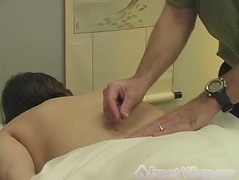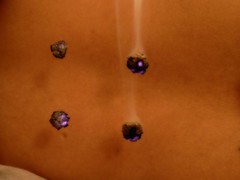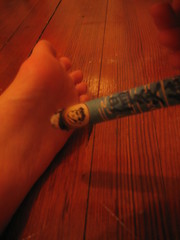 Acupuncture
Photo by: ExpertVillage.com
Acupuncture
Photo by: ExpertVillage.com
There are so many different aspects to Traditional Chinese Medicine, and acupuncture is an integral aspect of this medicine, along with the herbs, other methods, and energy work. I'm going to use TCM and acupuncture interchangeably in this blog, as I've noticed that they are often used that way in conversations about what it is and how it heals.
I would think that the most common reasons people come to acupuncturists is for pain control. Upper, middle and lower back pain, shoulder, knee and ankle pain, fibromyalgia (a chronic syndrome often characterized by fatigue and pain throughout the body), and headaches to name several. Migraine and tension-headache treatments can also be quite successful, and even if the initial outcome is simply reducing the amount of medication. I know many ex-migraine sufferers have been more than satisfied with the results acupuncture produced.
A lot of sports injuries such as ankle and wrist sprains, fatigued or pulled muscles, broken bones, and other serious injuries are also successfully treated by acupuncture. My personal experience was lateral knee pain when I was training for a half-marathon, and I was experiencing it at least once per week for three weeks. I went into the acupuncturist for a treatment with needles, some bloodletting (more on that later-it's not as bad as it sounds!) and an herbal patch. The next day there was no pain at all. With acute injuries, the healing time is often faster, as the injury is recent.
Having said that, keep in mind that it does take time to see results with chronic injuries. There is a somewhat "tried and true" formula that for however many years you have experienced the pain or headaches, it will take treatments twice a week for the same amount of months to achieve a realistic result. For example, I had serious allergy and asthma symptoms for around 4-5 years. I was able to get treatments in Korea 2-3 times per week for four months, and I experienced a significant decrease in symptoms.
Enough to make me apply to acupuncture school.
Check back soon for more information on the many, many other conditions that Traditional Chinese Medicine can treat!
Technorati Tags: acupuncture, pain, migraine, headache, sports injuries, acupuncture treatment
 Photo from: www.portlandmonthlymag.com
Photo from: www.portlandmonthlymag.com



 Photo: Larry Towell/Magnum, for The New York Times
Photo: Larry Towell/Magnum, for The New York Times





 Miriam Lee (left) with her student, Susan Johnson, L.Ac.
Photo taken from: www.tungspoints.com/miriamlee
Miriam Lee (left) with her student, Susan Johnson, L.Ac.
Photo taken from: www.tungspoints.com/miriamlee



